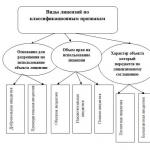Acmeism Acmeism (from the Greek akme - the highest degree, peak, flowering, blooming time) is a literary movement that is opposed to symbolism and arose at the beginning. Silver Age Acmeism Presentation on the topic Acmeism in literature
Description of the presentation by individual slides:
1 slide
Slide description:
Western European and domestic sources of acmeism Prepared by Irina Aleksandrovna Strakhova, teacher of Russian language and literature of the 1st qualification category, MBOU "Polyanskaya secondary school" Spassky district of the Republic of Tatarstan
2 slide

Slide description:
Objectives: to give an idea of Acmeism; highlight the main features of his poetics; give a brief description of the work of the Acmeist poets.
3 slide

Slide description:
“The retinue makes the king” The two largest poets of Acmeism, A. Akhmatova and O. Mandelstam, had already gone beyond the boundaries of this school by the mid-1910s, and G. Ivanov and G. Adamovich most fully met the requirements of Acmeism A. Akhmatova O. Mandelstam G. Ivanov, G. Adamovich
4 slide

Slide description:
Acmeism is a modernist movement (from the Greek akme tip, pinnacle, highest degree, pronounced quality), which declared a concrete sensory perception of the external world, returning the word to its original, non-symbolic meaning.
5 slide

Slide description:
The beginning of their creative journey Young poets, future Acmeists, were close to symbolism, attended “Ivanovo Wednesdays” in the St. Petersburg apartment (in the “tower”) of Vyach. Ivanova. Young poets were taught versification here. In October 1911, they founded a new literary association, the Workshop of Poets. “The Workshop” was a school of professional excellence, and its leaders were the young poets N. Gumilyov and S. Gorodetsky N. Gumilyov S. Gorodetsky, 1910
6 slide

Slide description:
Western European and domestic origins of Acmeism The founder of this unique “guild” of poets was Pushkin himself. Speaking as a faithful follower of the work of Peter the Great, Pushkin in almost every verse testifies to the deepest knowledge and subtlest understanding of the national poetic element of each people. Pushkin's miracle could not have come true without a strong push from the dominant culture of that time, that is, French culture. Are not Voltaire and even Guys, not to mention Moliere, Racine, Corneille, François Villon, nameless authors of folk epic songs, creative stimulators of Pushkin on a par with Derzhavin and Batyushkov or with fairy tales and legends of Russian folklore? The modernists are discovering a new Europe; they are attracted especially by France, but they are also receptive to the call of Africa and Asia, ancient history and even prehistory.
7 slide

Slide description:
Western European and domestic sources of Acmeism In the first collection of poems “The Path of the Conquistadors”, Gumilyov fails to hide his dependence on those poets who too clearly influence his style: Bryusov and Balmont among the Russians, and among the French poets grouped around “Modern Parnassus”, in features by C. Lecomte de Lisle and J. M. Heredia. The very image of a conquistador must have arisen in his mind when he saw a portrait of Heredia, one of his then most beloved poets, in the luxurious fake armor of a conquistador. Critics have repeatedly noted that as a poet Gumilev acted under a mask. And I am related to the hippopotamus: Dressed in the armor of my shrines, I walk solemnly and straight Without fear in the middle of the deserts. These verses from “Miscellaneous Poems” by Théophile Gautier, skillfully translated by Gumilyov, could serve as an epigraph to his entire life.
8 slide

Slide description:
The Association of Acmeists lasted about 2 years (1913-1914). It also included A. Akhmatova, O. Mandelstam, M. Zenkevich, V. Narbut and others. In the article “The Legacy of Symbolism and Acmeism,” Gumilyov criticized symbolism for mysticism, for its fascination with the “region of the unknown.” The article proclaimed “the intrinsic value of every phenomenon”
Slide 9

Slide description:
Acmeism - Adamism This interpretation implied a “courageously firm and clear outlook on life.” The world is spacious and sonorous, And it is more sonorous than rainbows, And so the world is entrusted to Adam, the Inventor of names. To name, to recognize, to tear off the veils of both idle secrets and decrepit darkness - This is the first feat. A new feat - to sing praises to the Living Earth. (S. Gorodetsky “Adam”)
10 slide

Slide description:
Requirements of Acmeism He believes in weight, he honors space, He tenderly loves materials, He does not reproach substances for their slowness and constancy. Stanzas the obedient quadriga He loves - having violently dispersed - Stop. And he is right in that, that in eternity he is submissive to the moment. (1913, S. Gorodetsky to O. Mandelstam) Acmeists are interested in the real, not the other world, the beauty of life in its concrete sensory manifestations. The vagueness and hints of symbolism were contrasted with a major perception of reality, the authenticity of the image, and the clarity of the composition.
11 slide

Slide description:
Hero of Gumilev This is a traveler, a conquistador, a man of strong will. The poet's poems contain romantic motifs, geographical and historical exoticism. He is given graceful harmony and bliss, and his skin is decorated with a magical pattern, which only the moon dares to equal, crushing and swaying on the moisture of wide lakes. (1907, “Giraffe”) N.S. Gumilev (1886-1921)
To use presentation previews, create a Google account and log in to it: https://accounts.google.com
Slide captions:
Acmeism as a literary movement Lukyanova S.E.
Acmeism arose as a reaction to symbolism. Acmeism is a modernist movement (from the Greek akme - edge, pinnacle, highest degree, pronounced quality), which declared a concrete sensory perception of the external world, returning the word to its original, non-symbolic meaning.
Basic principles of Acmeism: liberation of poetry from symbolist appeals to the ideal, returning it to clarity; rejection of mystical nebula, acceptance of the earthly world in its diversity, visible concreteness, sonority, colorfulness; the desire to give a word a certain, precise meaning; objectivity and clarity of images, precision of details; appeal to a person, to the “authenticity” of his feelings; poeticization of the world of primordial emotions, primitive biological natural principles; echoes of past literary eras, broad aesthetic associations, “longing for world culture.”
A. Akhmatova (Gorenko) B. Pasternak I. Anensky G. Ivanov N. Gumilyov O. Mandelstam
At the beginning of their creative career, young poets, future Acmeists, were close to symbolism and attended “Ivanovo Wednesdays” - literary meetings in Vyach’s St. Petersburg apartment. Ivanov, called the “tower”. In the “tower” classes were held for young poets, where they learned poetry. In October 1911, students of this “poetry academy” founded a new literary association, “The Workshop of Poets.” The workshop was a school of professional excellence, and its leaders were the young poets N. Gumilyov and S. Gorodetsky. In January 1913, they published declarations of the acmeist group in the Apollo magazine. S. Gorodetsky N. Gumilyov
“Some trends in modern Russian poetry” “The struggle between Acmeism and symbolism... is, first of all, a struggle for this world, sounding, colorful, having forms, weight and time...” “the world is irrevocably accepted by Acmeism, in all its beauty and ugliness”
The new movement was given another interpretation - Adamism, implying a “courageously firm and clear outlook on life.” This view is clarified in S. Gorodetsky’s poem “Adam”
Adam Forgive me, captivating moisture And primordial fog! In the transparent wind there is more good for the countries created for life. The world is spacious and multi-voiced And more colorful than rainbows, And now it is entrusted to Adam, the Inventor of names. To name, to recognize, to tear off the covers of both idle secrets and decrepit darkness - This is the first feat. A new feat - to sing praises to the Living Earth.
Acmeists are interested in the real, not the other world, the beauty of life in its concrete sensory manifestations. The vagueness and hints of symbolism were contrasted with a major perception of reality, the reliability of the image, and the clarity of the composition.
O. E. Mandelstam He believes in weight, he honors space, He dearly loves materials. He did not reproach substances for their slowness and constancy. Stanzas of the obedient quadriga - He loves, having violently dispersed, to stop. And in this he is right, That in eternity he is submissive to the moment.
N.S. Gumilev The hero of N. Gumilev is a traveler, a conquistador, a man of strong will. Gumilyov's poetry contains romantic motifs, geographical and historical exoticism. Exotic detail sometimes plays a purely picturesque role
Today, I see, your look is especially sad, And your arms are especially thin, hugging your knees. Listen: far, far away, on Lake Chad Exquisite, a giraffe wanders. He is given graceful slenderness and bliss, and his skin is decorated with a magical pattern, which only the moon dares to equal, crushing and swaying on the moisture of wide lakes. In the distance it is like the colored sails of a ship, And its flight is smooth, like the joyful flight of a bird. I know that the earth sees many wonderful things, When at sunset he hides in a marble grotto. I know funny tales of mysterious countries About a black maiden, about the passion of a young leader, But you have been breathing in the heavy fog for too long, You don’t want to believe in anything but rain. And how can I tell you about the tropical garden, about slender palm trees, about the smell of incredible herbs... -Are you crying? Listen... far away, on Lake Chad Exquisite, a giraffe wanders. Giraffe
Anna Akhmatova A. Akhmatova is alien to exoticism. The meaning of her life is love. Feelings are reflected in the objective world, in everyday details, in a psychologically significant gesture. The outside world, everyday details became the subject of poetry
The pillow is already hot on both sides. So the second candle goes out and the cry of the crows becomes more and more audible. I didn’t sleep last night, It’s too late to think about sleep... How unbearably white is the Curtain on the white window. Hello!
The Acmeist movement existed for about two years (1913-1914). The creative searches of poets went beyond the scope of Acmeism. The humanistic meaning of this movement was significant - to revive a person’s thirst for life, to restore the feeling of its beauty.
http://gold-library.com/akmeisti/ N.V. Egorova. Lesson developments in Russian literature. 11th grade.
Description of the presentation by individual slides:
1 slide
Slide description:
Color Blooming power The highest degree Acmeism (from the Greek akme - the highest degree of something, blossoming, maturity, peak, edge) is one of the modernist movements in Russian poetry of the 1910s, formed as a reaction to the extremes of symbolism.
2 slide

Slide description:
N. Gumilyov “The Legacy of Symbolism and Acmeism” (1913) “Symbolism is being replaced by a new direction, no matter what it is called, whether Acmeism or Adamism, in any case, requiring a greater balance of forces or a more accurate knowledge of the relationship between subject and object than that was in symbolism... In circles close to Acmeism, the names of Shakespeare, Rabelais, Villon and Théophile Gautier are most often uttered. The selection of these names is not arbitrary. Each of them is a cornerstone for the building of Acmeism, a high tension of one or another of its elements. Shakespeare showed us the inner world of man. Rabelais - his body and joy, wise physiology. Villon told us about a life that does not doubt itself at all, although it knows everything: God, and vice, and death, and immortality; Théophile Gautier found in art worthy clothes of impeccable shapes for this life. To combine these four moments in oneself is the dream that unites people who so boldly called themselves Acmeists..."
3 slide

Slide description:
O. Mandelstam “The Morning of Acmeism” (1912) “For Acmeists, the conscious meaning of the word... is the same beautiful form as music for the Symbolists... Love the existence of a thing more than the thing itself and your being more than yourself - this is the highest commandment of Acmeism... We loved the music of evidence... We don’t fly, we only climb towers that we can build ourselves... The Middle Ages are dear to us because they never mixed different plans and treated the other world with great restraint. A noble mixture of rationality and a sense of the world as a living balance brings us closer to this era..."
4 slide

Slide description:
Acmeism grew out of symbolism. 1909 - young poets who attended Symbolist meetings with the St. Petersburg poet V. Ivanov created the “Poetry Academy”, where they studied the theories of versification. 1911 – Academy students founded a new association, “The Workshop of Poets.” 1912 is the year of birth of a new movement - Acmeism.
5 slide

Slide description:
6 slide

Slide description:
7 slide

Slide description:
8 slide

Slide description:
no to symbolist impulses towards the “ideal”; there is no polysemy and fluidity of images, complicated metaphoricality; a return to the material world, an object (or element of “nature”), the exact meaning of a word.
Slide 9

Slide description:
Basic principles of Acmeism: - liberation of poetry from symbolist appeals to the ideal, returning it to clarity; - rejection of mystical nebula, acceptance of the earthly world in its diversity, visible concreteness, sonority, colorfulness; - the desire to give a word a specific, precise meaning; - objectivity and clarity of images, precision of details; - appeal to a person, to the “authenticity” of his feelings; - poeticization of the world of primordial emotions, primitive biological natural principles; - a echo of past literary eras, the broadest aesthetic associations, “longing for world culture.”
10 slide

Slide description:
Clarity, simplicity, affirmation of real life! BUT: Acmeism is characterized by certain modernist motifs, a tendency towards aestheticism, intimacy or poeticization of the feelings of primordial man.
11 slide

Slide description:
A little red wine, A little sunny May - And, breaking a thin biscuit, Whiteness of the thinnest fingers. O. Mandelstam.
12 slide

Slide description:
Reading poetry... Osip Mandelstam “Slower than the snow hive...” “On pale blue enamel...”
Slide 13

Slide description:
Slide 14

Slide description:
15 slide

Slide description:
16 slide

Slide description:
Slide 17

Slide description:
GIRAFFE Today, I see, your look is especially sad And your arms are especially thin, hugging your knees. Listen: far, far away, on Lake Chad Exquisite, a giraffe wanders. He is given graceful slenderness and bliss, and his skin is decorated with a magical pattern, which only the moon dares to equal, crushing and swaying on the moisture of wide lakes. In the distance it is like the colored sails of a ship, And its flight is smooth, like the joyful flight of a bird. I know that the earth sees many wonderful things, When at sunset he hides in a marble grotto. I know funny tales of mysterious countries About a black maiden, about the passion of a young leader, But you have been breathing in the heavy fog for too long, You don’t want to believe in anything other than rain. And how I will tell you about the tropical garden, About the slender palm trees, about the smell of incredible herbs. Are you crying? Listen... far away, on Lake Chad Exquisite, a giraffe wanders. N. Gumilev
18 slide

Slide description:
Acrostic poem An angel lay down at the edge of the sky, bending down and marveling at the abyss. The new world was dark and starless. Hell was silent. Not a groan was heard. Scarlet blood timid beating, Fragile hands fright and shudder, The world of dreams received a holy reflection in the possession of an Angel. The world is crowded! Let him live, dreaming of love, of sadness and of shadow, In the eternal darkness, revealing the ABC of his own revelations. N. Gumilev
Slide 19

Slide description:
The door is half open, the linden trees are blowing sweetly... The whip and the glove are forgotten on the table. The circle from the lamp is yellow... I listen to the rustling sounds. Why did you leave? I don’t understand... Anna Akhmatova
20 slide

Valentin Innokentievich Krivich (real name Annensky) (1880-1936) - son of the poet Innokenty Fedorovich Annensky, a lawyer by training, served as an official in St. Petersburg, lived almost his entire life in Tsarskoe Selo. He made his debut in 1902 in the “Literary and Artistic Collection”, then sometimes published poems and literary reviews in metropolitan magazines. The only collection of poems, “Flower Grasses” (1912), was read and reviewed in manuscript by In. Annensky (the poet’s father), noting the “true taste” and “some bending” in tone, akin to his own lyrics, but I. Bunin and A. Blok had a much greater influence on V. Krivich’s work. After the death of his father, he was engaged in disassembling his archive and publishing the creative heritage of In. Annensky for publication, wrote the work “I. Annensky according to family memories." His most significant poems were created in the 1920s and for the most part remained unpublished.
Slide 1
Slide 2
 Definition ACMEISM is a modernist movement that declared a concrete sensory perception of the external world, returning the word to its original, non-symbolic meaning. The name "Acmeism" comes from the Greek. “acme” - tip, top
Definition ACMEISM is a modernist movement that declared a concrete sensory perception of the external world, returning the word to its original, non-symbolic meaning. The name "Acmeism" comes from the Greek. “acme” - tip, top
Slide 3
 History The Acmeist association itself was small and existed for about two years (1913-1914). But blood ties connected him with the “Workshop of Poets”, which arose almost two years before the Acmeist manifestos and was renewed after the revolution. Members of the “Workshop” were mainly novice poets: A. Akhmatova, N. Burliuk, Vas. Gippius, M. Zenkevich, Georgy Ivanov, E. Kuzmina-Karavaeva, M. Lozinsky, O. Mandelstam, Vl. Narbut, P. Radimov. Meetings of the “Workshop” were attended by N. Klyuev and V. Khlebnikov. “Tseh” began publishing collections of poems and a small monthly magazine “Hyperborey”.
History The Acmeist association itself was small and existed for about two years (1913-1914). But blood ties connected him with the “Workshop of Poets”, which arose almost two years before the Acmeist manifestos and was renewed after the revolution. Members of the “Workshop” were mainly novice poets: A. Akhmatova, N. Burliuk, Vas. Gippius, M. Zenkevich, Georgy Ivanov, E. Kuzmina-Karavaeva, M. Lozinsky, O. Mandelstam, Vl. Narbut, P. Radimov. Meetings of the “Workshop” were attended by N. Klyuev and V. Khlebnikov. “Tseh” began publishing collections of poems and a small monthly magazine “Hyperborey”.
Slide 4
 In 1912, at one of the meetings of the Workshop, the issue of Acmeism as a new poetic school was resolved. The name of this movement emphasized the aspiration of its adherents to new heights of art. The main organ of the Acmeists was the magazine “Apollo” (edited by S. Makovsky), which published poems by the participants of the “Workshop”, article-manifestos by N. Gumilyov and S. Gorodetsky. The new movement in poetry opposed itself to symbolism, which, according to Gumilyov, “has completed its circle of development and is now falling” or, as Gorodetsky more categorically argued, is experiencing a “catastrophe.” However, in essence, the “new movement” was not at all antagonistic towards symbolism. The claims of the Acmeists turned out to be clearly unfounded.
In 1912, at one of the meetings of the Workshop, the issue of Acmeism as a new poetic school was resolved. The name of this movement emphasized the aspiration of its adherents to new heights of art. The main organ of the Acmeists was the magazine “Apollo” (edited by S. Makovsky), which published poems by the participants of the “Workshop”, article-manifestos by N. Gumilyov and S. Gorodetsky. The new movement in poetry opposed itself to symbolism, which, according to Gumilyov, “has completed its circle of development and is now falling” or, as Gorodetsky more categorically argued, is experiencing a “catastrophe.” However, in essence, the “new movement” was not at all antagonistic towards symbolism. The claims of the Acmeists turned out to be clearly unfounded.
Slide 5
 “We will fight for a strong and vital art beyond the painful disintegration of the spirit,” proclaimed the editors in the first issue of the magazine “Apollo” (1913), in which, in the article “The Legacy of Symbolism and Acmeism,” N. Gumilyov wrote: “Symbolism is being replaced by a new direction, no matter what it is called - whether acmeism (from the word ???? (“acme”) - the highest degree of something, color, blooming time), or Adamism (a courageously firm and clear view of life), - in in any case, requiring a greater balance of power and a more accurate knowledge of the relationship between subject and object than was the case in symbolism. However, in order for this movement to establish itself in its entirety and become a worthy successor to the previous one, it is necessary that it accept his inheritance and answer all the questions he posed. The glory of the ancestors obliges, and symbolism was a worthy father.”
“We will fight for a strong and vital art beyond the painful disintegration of the spirit,” proclaimed the editors in the first issue of the magazine “Apollo” (1913), in which, in the article “The Legacy of Symbolism and Acmeism,” N. Gumilyov wrote: “Symbolism is being replaced by a new direction, no matter what it is called - whether acmeism (from the word ???? (“acme”) - the highest degree of something, color, blooming time), or Adamism (a courageously firm and clear view of life), - in in any case, requiring a greater balance of power and a more accurate knowledge of the relationship between subject and object than was the case in symbolism. However, in order for this movement to establish itself in its entirety and become a worthy successor to the previous one, it is necessary that it accept his inheritance and answer all the questions he posed. The glory of the ancestors obliges, and symbolism was a worthy father.”
Slide 6
 Trying to dispel the atmosphere of the irrational, to free poetry from the “mystical fog” of symbolism, the Acmeists accepted the whole world - visible, sounding, audible. But this “unconditionally” accepted world turned out to be devoid of positive content.
Trying to dispel the atmosphere of the irrational, to free poetry from the “mystical fog” of symbolism, the Acmeists accepted the whole world - visible, sounding, audible. But this “unconditionally” accepted world turned out to be devoid of positive content.
Slide 7
 Every movement is in love with certain creators and eras. Dear graves connect people most of all. In circles close to Acmeism, the names most often mentioned are Shakespeare, Rabelais, Villon and Théophile Gautier. Each of these names is a cornerstone for the building of Acmeism, a high tension of one or another element. Shakespeare showed us the inner world of man; Rabelais – the body and its joys, wise physiology; Villon told us about a life that does not doubt itself at all, although it knows everything - God, vice, death, and immortality; Théophile Gautier found in art worthy clothes of impeccable shapes for this life. To combine these four moments in oneself is the dream that united the people who so boldly called themselves Acmeists.
Every movement is in love with certain creators and eras. Dear graves connect people most of all. In circles close to Acmeism, the names most often mentioned are Shakespeare, Rabelais, Villon and Théophile Gautier. Each of these names is a cornerstone for the building of Acmeism, a high tension of one or another element. Shakespeare showed us the inner world of man; Rabelais – the body and its joys, wise physiology; Villon told us about a life that does not doubt itself at all, although it knows everything - God, vice, death, and immortality; Théophile Gautier found in art worthy clothes of impeccable shapes for this life. To combine these four moments in oneself is the dream that united the people who so boldly called themselves Acmeists.
Slide 8
 Aesthetics of Acmeism: - the world must be perceived in its visible concreteness, appreciate its realities, and not tear yourself away from the ground; - the source of poetic values is on earth, and not in the unreal world; - we need to revive the love for our body, the biological principle in man, to value man and nature; - in poetry, 4 principles should be fused together: 1) the tradition of Shakespeare in depicting the inner world of man; 2) Rabelais’ traditions in glorifying the body; 3) Villon’s tradition in chanting the joys of life; 4) Gautier's tradition in glorifying the power of art.
Aesthetics of Acmeism: - the world must be perceived in its visible concreteness, appreciate its realities, and not tear yourself away from the ground; - the source of poetic values is on earth, and not in the unreal world; - we need to revive the love for our body, the biological principle in man, to value man and nature; - in poetry, 4 principles should be fused together: 1) the tradition of Shakespeare in depicting the inner world of man; 2) Rabelais’ traditions in glorifying the body; 3) Villon’s tradition in chanting the joys of life; 4) Gautier's tradition in glorifying the power of art.
Slide 9
 Basic principles of Acmeism: - liberation of poetry from symbolist appeals to the ideal, returning it to clarity; - rejection of mystical nebula, acceptance of the earthly world in its diversity, visible concreteness, sonority, colorfulness; - the desire to give a word a specific, precise meaning; - objectivity and clarity of images, precision of details; - appeal to a person, to the “authenticity” of his feelings; - poeticization of the world of primordial emotions, primitive biological natural principles; - a echo of past literary eras, the broadest aesthetic associations, “longing for world culture.”
Basic principles of Acmeism: - liberation of poetry from symbolist appeals to the ideal, returning it to clarity; - rejection of mystical nebula, acceptance of the earthly world in its diversity, visible concreteness, sonority, colorfulness; - the desire to give a word a specific, precise meaning; - objectivity and clarity of images, precision of details; - appeal to a person, to the “authenticity” of his feelings; - poeticization of the world of primordial emotions, primitive biological natural principles; - a echo of past literary eras, the broadest aesthetic associations, “longing for world culture.”
Slide 10
 Distinctive features of Acmeism: - hedonism (enjoyment of life), Adamism (animal essence), clarism (simplicity and clarity of language); - lyrical plot and depiction of the psychology of experience; - colloquial elements of language, dialogues, narratives. Acmeists are interested in the real, not the other world, the beauty of life in its concrete - sensual manifestations. The vagueness and hints of symbolism were contrasted with a major perception of reality, the reliability of the image, and the clarity of the composition. In some ways, the poetry of Acmeism is the revival of the “golden age,” the time of Pushkin and Baratynsky.
Distinctive features of Acmeism: - hedonism (enjoyment of life), Adamism (animal essence), clarism (simplicity and clarity of language); - lyrical plot and depiction of the psychology of experience; - colloquial elements of language, dialogues, narratives. Acmeists are interested in the real, not the other world, the beauty of life in its concrete - sensual manifestations. The vagueness and hints of symbolism were contrasted with a major perception of reality, the reliability of the image, and the clarity of the composition. In some ways, the poetry of Acmeism is the revival of the “golden age,” the time of Pushkin and Baratynsky.
Slide 11
 Acmeist poets Akhmatova Anna Gumilyov Nikolay Gorodetsky Sergei Zenkevich Mikhail Ivanov Georgy Krivich Valentin Lozinsky Mikhail Mandelstam Osip Narbut Vladimir Shileiko Vladimir G. Ivanov
Acmeist poets Akhmatova Anna Gumilyov Nikolay Gorodetsky Sergei Zenkevich Mikhail Ivanov Georgy Krivich Valentin Lozinsky Mikhail Mandelstam Osip Narbut Vladimir Shileiko Vladimir G. Ivanov
Slide 12






